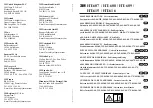
120 20195-100 Preliminary
Paragon4 – UHF, 700, & 800MHz User Manual
24
5.3 Additional test details
5.3.1 Carrier Deviations
Table 5 - Carrier Deviations
Carrier Modulation
SRRC4FSK
SRRC8FSK
SRRC16FSK
Tone
Tone
Network Speed
(kb/s)
Typical deviation
in kHz
(1000Hz test tone)
Network Speed
(kb/s)
Typical deviation
in kHz
(1000Hz test tone)
Network Speed
(kb/s)
Typical deviation
in kHz
(1000Hz test tone)
25 kHz Channel (UHF)
32.0
± 3.7
48.0
± 4.0
64.0
± 4.1
43.2
± 4.2
25 kHz Channel (800 MHz/700MHz)
32.0
± 2.4
48.0
± 2.7
64.0
± 2.9
43.2
± 3.3
12.5 kHz Channel (UHF/700MHz/Canada 800MHz)
16.0
± 1.5
24.0
± 1.8
32.0
± 1.8
NPSPAC Channel (USA – 800 MHz)
16.0
± 2.4
24.0
± 2.7
32.0
± 2.9
5.3.2 PF Switch
Nearly all test “Actions” described in tables 3 and 4 above can be done by selecting the relevant
test tone via the “Radio
►
Tests” page of the web interface. However, stopping the Airlink for a
test is done in a different manner. It requires the use of the BSC’s front-mounted PF key rocker
switch
(detailed PF operation in the next paragraph
). The PF switch can also be used as an alter-
nate way of selecting Test Tones or if a web connection is unavailable.
5.3.2.1
Stopping the Airlink and Alternate Test Tone Selection Method
Located on the BSC module, the PF key is a horizontally mounted rocker switch with a center
detent and spring-loaded positions “1” and “2”. Pressing the switch to
position “1” causes the “Status” LED to blink green once only followed by
amber blinks at one-second intervals as long as it is held pressed. Pressing
the switch to position “2” is used to select test tones as shown in Table 6
below.
Figure 16 - PF Switch Rocker Detail (one side pressed)








































